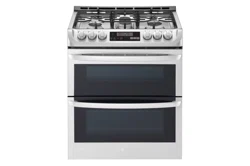Documents: Go to download!
- User Manual - (English, Spanish)
USER MANUAL
PRODUCT OVERVIEW
Parts
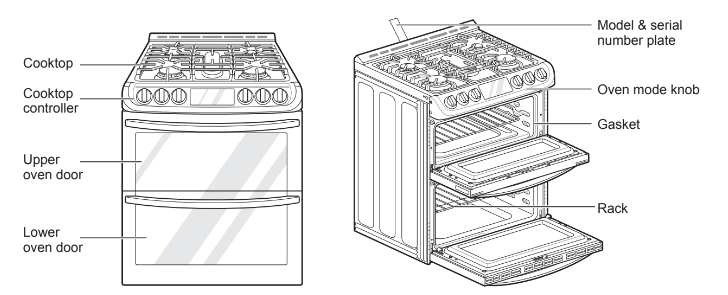
Accessories
Included Accessories
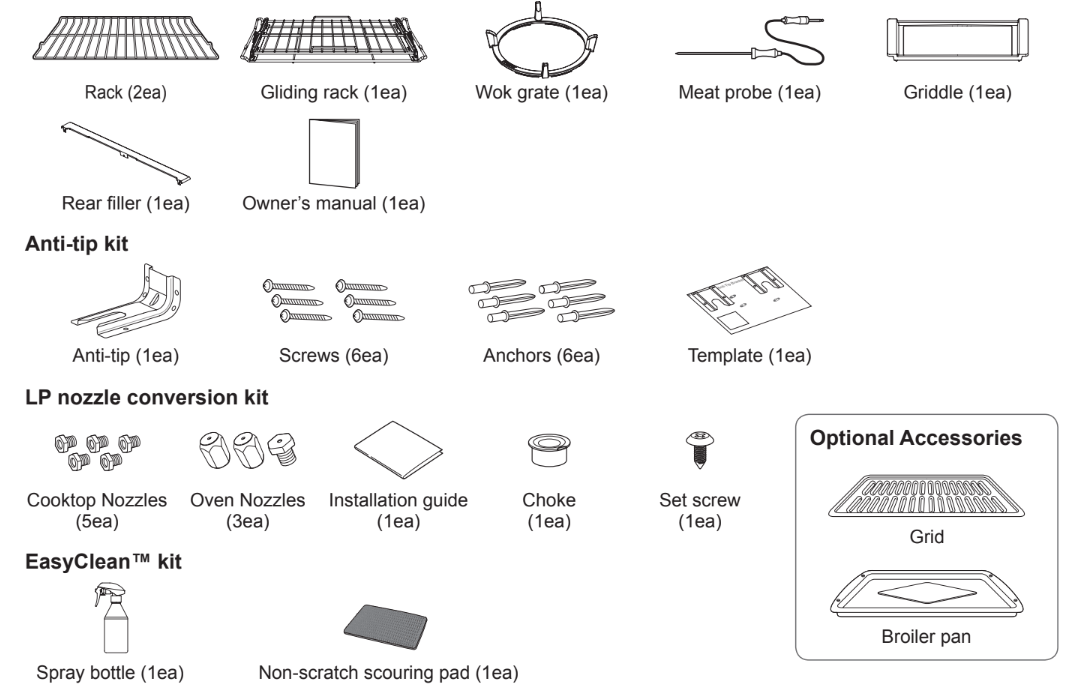
INSTALLATION
Before Installing the Range
Make sure your range is properly installed and grounded by a qualified installer, according to the installation instructions. Any adjustment and service should be performed only by qualified gas range installers or service technicians.
In the Commonwealth of Massachusetts
- This product must be installed by a licensed plumber or gas fitter.
- When using ball type gas shut-off valves, they must be the T-handle type.
- When using a flexible gas connector, it must not exceed 3 feet in length.
Preparing for Installation
Tools Needed
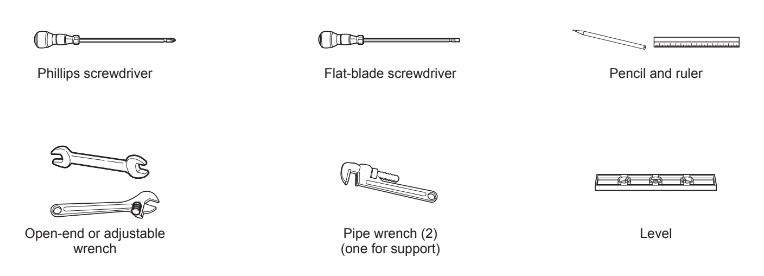
Materials You May Need
- Gas line shut-off valve
- Pipe joint sealant that resists action of natural and LP gases
- Flexible metal appliance connector (3/4" or 1/2" NPT x 1/2" I.D.)
- Never use an old connector when installing a new range.
- Flare union adapter for connection to gas supply line (3/4" or 1/2" NPT x 1/2" I.D.)
- Flare union adapter for connection to pressure regulator on range (1/2" NPT x 1/2" I.D.)
- Liquid leak detector or soapy water
- Lag bolt or 1/2" O.D. sleeve anchor (for concrete floors only)
Installing the Range
Unpacking and Moving the Range
Remove packing material, tape and any temporary labels from your range before using. Do not remove any warning-type labels, the model and serial number label, or the Tech Sheet that is located on the back of the range.
To remove any remaining tape or glue, rub the area briskly with your thumb. Tape or glue residue can also be easily removed by rubbing a small amount of liquid dish soap over the adhesive with your fingers. Wipe with warm water and dry.
Do not use sharp instruments, rubbing alcohol, flammable fluids, or abrasive cleaners to remove tape or glue. These products can damage the surface of your range.
Your range is heavy and can be installed on soft floor coverings such as cushioned vinyl or carpeting.
Use care when moving the range on this type of flooring. Use a belt when moving the range to prevent damaging the floor. Or slide the range onto cardboard or plywood to avoid damaging the floor covering.
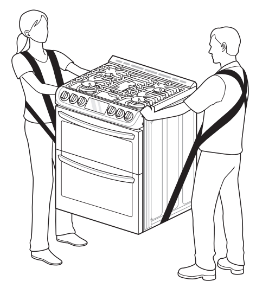
Choosing the Proper Location
Do not locate your range where it may be subject to strong drafts. Any openings in the floor or wall behind the range should be sealed. Make sure the openings around the base of the range that supply fresh air for combustion and ventilation are not blocked by carpeting or woodwork.
Your range, like many other household units, is heavy and can be installed on soft floor coverings such as cushioned vinyl or carpeting. Use care when moving the range on this type of flooring.
This appliance must not be installed with a ventilation system that blows air downward toward the range.
This type of ventilation system may cause ignition and combustion problems with the gas cooking appliance resulting in personal injury or unintended operation.
When the floor covering ends at the front of the range, the area that the range will be installed on should be built up with plywood to the same level or higher than the floor covering. This will allow the range to be moved for cleaning and servicing, as well as provide proper air flow to the range.
Also, make sure the floor covering can resist temperatures of at least 167 °F (75 °C). See the
Installation Safety Instructions included in this manual.
Make sure the wall coverings around your range can resist the heat generated up to 194 °F (90 °C) by the range. See the Installation Safety Instructions included in this manual.
Gas Pipe and Electrical Outlet Locations
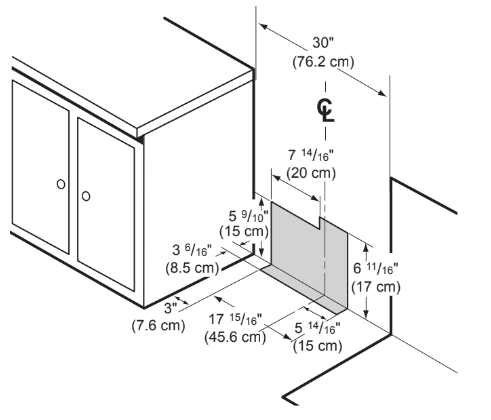
Dimensions and Clearances
Provide proper clearance between the range and adjacent combustible surfaces. These dimensions must be met for safe use of your range. The location of the electrical outlet and pipe opening (see Gas Pipe and Electrical Outlet Locations, page 14) may be adjusted to meet specific requirements. The range may be placed with 0" clearance (flush) at the back wall.
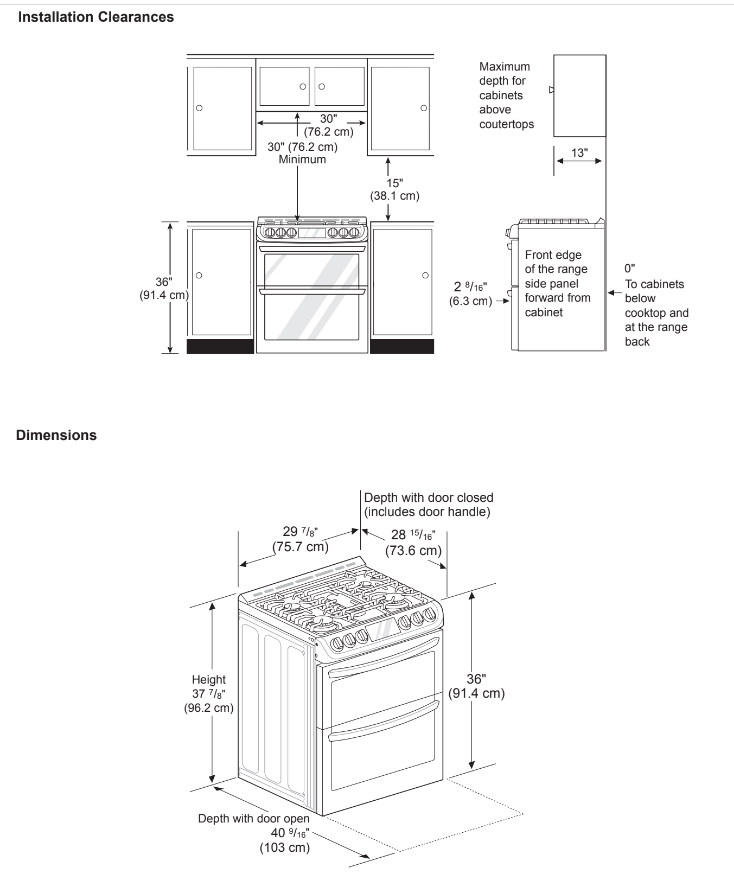
Installing the Anti-tip Device

The anti-tip bracket is packaged with an installation template. The instructions include necessary information to complete the installation. Read and follow the range installation instruction sheet.
Optional Rear Filler
If the counter does not bridge the opening at the rear wall, use the rear filler kit provided with the slide-in range.
If the countertop depth is less than 24", the control panel will not sit flush with the countertop.
Installing the Rear Filler
- Using a screwdriver, remove the three screws holding the rear bracket in place.
- Attach the rear bracket and filler assembly as shown, using the three screws removed in step 1.
Providing Adequate Gas Supply
Your range is designed to operate at a pressure of of water column on natural gas or 10" of water column on LP.
Make sure you are supplying your range with the type of gas for which it is configured.
This range is convertible for use on natural or LP gas.
When using this range on LP gas, conversion must be made by a qualified LP installer before attempting to operate the range.
For proper operation, the pressure of natural gas supplied to the regulator must be between 5" and 13" of water column.
For LP gas, the pressure supplied to the regulator must be between 10" and 13" of water column. When checking for correct operation of the regulator, the inlet pressure must be at least 1" more than the operating (manifold) pressure as given above.
The pressure regulator located at the inlet of the range must remain in the supply line regardless of which type of gas is being used.
A flexible metal appliance connector used to connect the range to the gas supply line should have an I.D. of 5/8" and a maximum length of 5 feet. In Canada, flexible connectors must be single wall metal connectors less than 6 feet in length.
Connecting the Range to Gas
Shut off the range gas supply valve before removing the old range and leave it off until the new hook-up has been completed.
Because hard piping restricts movement of the range, the use of a CSA International-certified flexible metal appliance connector should be used unless local codes require a hard-piped connection.
A manual valve shall be installed in an accessible location in the gas piping external to the appliance for the purpose of turning on or shutting off gas to the appliance.
Never reuse an old connector when installing a new range.
To protect against gas leaks, use a qualified pipe joint sealant on all external threads.
1. Install a male 1/2" or 3/4" flare union adapter to the NPT internal thread of the manual shut-off valve, taking care to back-up the shut-off valve to keep it from turning.
2. Install a male 1/2" flare union adapter to the ½" NPT internal thread at the inlet of the pressure regulator. Use a backup wrench on the pressure regulator fitting to prevent damage.
Check that the gas pressure regulator valve is in the open position.
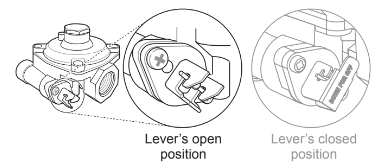
3. Connect a flexible metal appliance connector to the adapter on the range. Position the range to permit connection at the shut-off valve.
4. When all connections have been made, be sure all range controls are in the OFF position and the pressure regulator valve is open before turning on the main gas supply valve. Gas leaks may occur in the system and create a hazard. Gas leaks may not be detected by smell alone.
Check all gas connection joints and fittings for leaks with a non-corrosive leak detection fluid, then wipe off.
Gas suppliers recommend you purchase and install a UL approved gas detector. Install and use in accordance with the installation instructions.
Flexible Connector Hookup
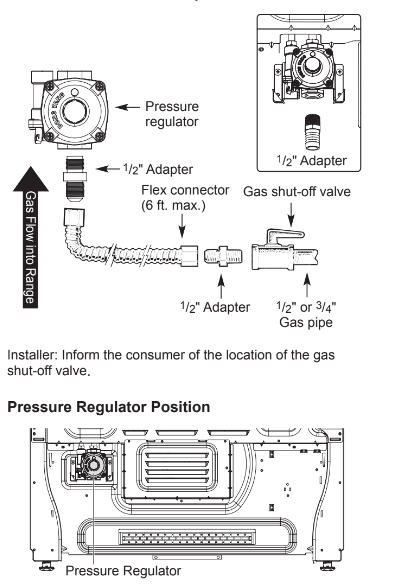
Electrical Connections
Electrical Requirements
120 Volt, 60 Hz, properly grounded dedicated circuit protected by a 15 or 20 Amp circuit breaker, or slow blow fuse.
If an external electrical source is utilized, the appliance, when installed, must be electrically grounded in accordance with local codes or, in the absence of local codes, with the National Electrical Code, ANSI/NFPA 70.
Grounding
IMPORTANT: FOR PERSONAL SAFETY, THIS APPLIANCE MUST BE PROPERLY GROUNDED.
The power cord of this appliance is equipped with a 3-prong (grounding) plug which mates with a standard 3-prong grounding wall receptacle to minimize the possibility of electric shock hazard from this appliance.
The customer should have the wall receptacle and circuit checked by a qualified electrician to make sure the receptacle is properly grounded.
Where a standard two-prong wall receptacle is encountered, it is the personal responsibility and obligation of the customer to have it replaced with a properly grounded three-prong wall receptacle.
DO NOT, UNDER ANY CIRCUMSTANCES, CUT OR REMOVE THE THIRD (GROUND) PRONG FROM THE POWER CORD.
A word about GFCI’s – GFCI’s are not required or recommended for gas range receptacles.
Ground Fault Circuit Interrupters (GFCI’s) are devices that sense leakage of current in a circuit and automatically switch off power when a threshold leakage level is detected. These devices must be manually reset by the consumer. The National Electrical Code requires the use of GFCI’s in kitchen receptacles installed to serve countertop surfaces.
Performance of the range will not be affected if operated on a GFCI-protected circuit but the occasional resetting of the circuit can become an annoyance.
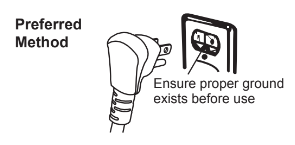
Sealing the Openings
Seal any openings in the wall and floor after electrical and gas supplies are completed.
Assembling the Surface Burners
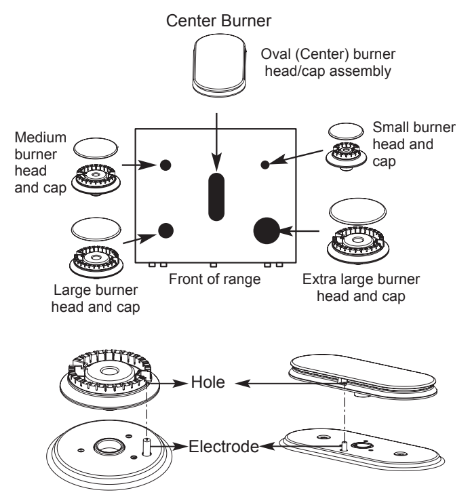
Place the burner caps and heads on the cooktop.
Make sure that the caps and heads are placed in the correct locations. There is one small, one medium, one large, one oval (center), and one extra large burner head and cap.
Make sure the hole in the burner head is positioned over the electrode.
Checking Ignition of the Surface Burners
Electric Ignition
Select a surface burner knob and simultaneously push in and turn to the Lite position. You will hear a clicking sound indicating proper operation of the spark module.
Once the air has been purged from the supply lines the burner should ignite within 4 seconds. After the burner ignites, rotate the knob out of the Lite position.
Try each burner in succession until all burners have been checked.
Quality of Flames
The combustion quality of the burner flames needs to be confirmed visually.
 A Yellow flames - Call for service.
A Yellow flames - Call for service.
 B Yellow tips on outer cones - This is normal for LP gas
B Yellow tips on outer cones - This is normal for LP gas
 C Soft blue flames - This is normal for natural gas
C Soft blue flames - This is normal for natural gas
Adjusting the Surface Burner to the Low Flame (Simmer) Setting
1. Light all surface burners.
2. Turn the knob on the burner being adjusted to Lo.
3. Remove the knob.
4. Insert a small, flat-blade screwdriver into the valve shaft.

5 . Replace the knob.
6. Test the flame stability.
Test 1: Turn the knob from Hi to Lo quickly. If the flame goes out, increase the flame size and test again.
Test 2: With the burner on a Lo setting, open and close the oven door quickly. If the flame is extinguished by the air currents created by the door movement, increase the flame height and test again.
7. Repeat steps 1-6 for each surface burner.
Checking Operation of Bake / Broil Burners
To check ignition of the Bake burner, follow the steps below:
- Remove all packing from inside the oven cavity.
- Turn oven mode knob to select Bake. 350 °F appears in the display.
- Press Start.
It may take between 30 and 90 seconds for the burner to start heating.
To check ignition of the Broil burner, follow the steps below:
- Turn oven mode knob to select Broil. Hi appears in the display.
- Make sure the door is closed.
- Press Start.
It may take between 30 and 90 seconds for the burner to start heating.
Adjusting Air Shutters (for LP Conversions)
The range comes from the factory with the air shutters adjusted for proper air flow for natural gas.
If converted to LP, follow the instructions provided in the conversion kit to properly adjust the air shutters.
LP conversion must be performed by a qualified technician.
Leveling the Range
Level the range by adjusting the leveling legs.
Extending the legs slightly may also make it easier to insert the rear leg into the anti-tip bracket.
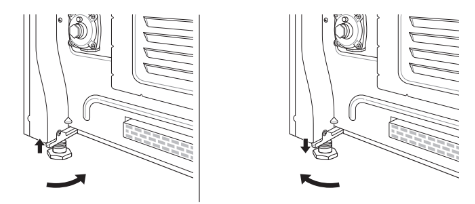
Use a level to check your adjustments. Place the level diagonally on the oven rack, and check each direction for level.
First check direction 1 .
Then check direction 2 . If the level doesn’t show level on the rack, adjust the leveling legs.
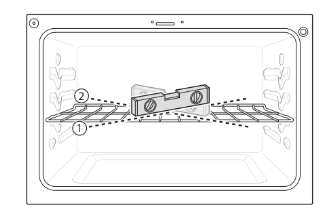
Engaging the Anti-tip Device
- Slide the range against the wall, making sure the back leg slides into and engages the anti-tip bracket.
- Check for proper installation by grasping the front edge of the cooktop and carefully attempting to tilt the range forward.

OPERATION
Gas Surface Burners
Before Use
Read all instructions before using.
Make sure that all burners are properly placed.
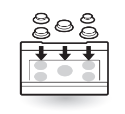
Make sure that all grates are properly placed before using the burner.
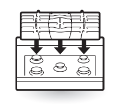
Make sure the burners and grates are cool before touching them, or placing a pot holder, cleaning cloth, or other materials on them.
Touching grates before they cool down may cause burns.
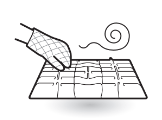
Burner Locations
Your gas range cooktop has four or five sealed gas burners, depending on the model. These can be assembled and separated. Follow the guide below.

1. Medium and Large Burners
The medium and large burners are the primary burners for most cooking. These general purpose burners can be turned down from Hi to Lo to suit a wide range of cooking needs.
2 . Small Burner
The smallest burner is used for delicate foods such as sauces or foods that require low heat for a long cooking time.
3. Extra Large Burner
The extra large burner is the maximum output burner. Like the other four burners, it can be turned down from Hi to Lo for a wide range of cooking applications. This burner is also designed to quickly bring large amounts of liquid to a boil. It can be used with cookware 10 inches or larger in diameter.
4. Oval Burner
The center, oval burner is for use with a griddle or oval pots.
Using the Gas Surface Burners
- Be sure that all of the surface burners and grates are placed in the correct positions.
- Place cookware on the grate.
- Push the control knob and turn to the Lite position.
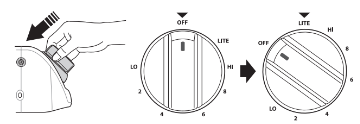
The electric spark ignition system makes a clicking noise.
4. Turn the control knob to control the flame size.
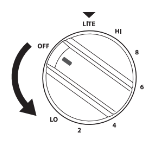
Setting the Flame Size
Watch the flame, not the knob, as you reduce heat.
Match the flame size on a gas burner to the cookware being used for fastest heating.
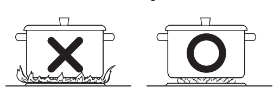
In Case of Power Failure
In case of a power failure, you can light the gas surface burners on your range with a match.
Surface burners in use when an electrical power failure occurs will continue to operate normally.
- Hold a lit match to the burner, then push in the control knob.
- Turn the control knob to the Lo position.
Range-Top Cookware
| Aluminum | Medium-weight cookware is recommended because it heats quickly and evenly. Most foods brown evenly in an aluminum skillet. Use saucepans with tight fitting lids when cooking with minimum amounts of water. |
| Cast-Iron | If heated slowly, most skillets will give satisfactory results. |
| Stainless Steel | This metal alone has poor heating properties and is usually combined with copper, aluminum or other metals for improved heat distribution. Combination metal skillets work satisfactorily if they are used with medium heat as the manufacturer recommends. |
| Enamelware | Under some conditions, the enamel of this cookware may melt. Follow cookware manufacturer’s recommendations for cooking methods. |
| Glass | There are two types of glass cookware. Those for oven use only and those for top-of-range cooking. |
| Heatproof Glass Ceramic | Can be used for either surface or oven cooking. It conducts heat very slowly and cools very slowly. Check cookware manufacturer’s directions to be sure it can be used on gas ranges. |
Using a Wok
If using a wok, use a 14-inch or smaller flat-bottomed wok. Make sure that the wok bottom sits flat on the grate.
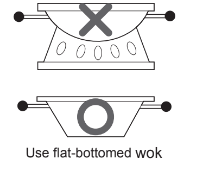
Using Stove-Top Grills
Do not place stove-top grills on the burner.

Using the Griddle
The non-stick coated griddle provides an extra-large cooking surface for meats, pancakes or other food usually prepared in a frying pan or skillet.

How to Place the Griddle: The griddle can only be used with the center burner. The griddle must be properly placed on the center grate, as shown below.
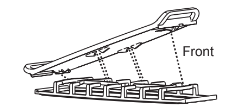
Preheat the griddle according to the guide below and adjust for the desired setting.

The Oven
Before Use
Read all instructions before using.
Make sure the electrical power cord and the gas valve are properly connected.
Confirm the correct usage of the range for the type of food you will cook.
Make sure you know how to use the oven temperature setting, time setting and recipe) for best results.
Choose the upper or lower oven for proper cooking.
Use the upper oven to cook a small amount of food.
In case of power failure, do not use the oven.
The oven and broiler cannot be used during a power outage. If the oven is in use when a power failure occurs, the oven burner shuts off and cannot be re-lit until power is restored. Once power is restored, you will need to reset the oven (or Broil function).

Do not attempt to operate the electric ignition during an electrical power failure.
Do not block, touch or place items around the oven vent during cooking.
Your oven is vented through ducts at the center above the burner grate. Do not block the oven vent when cooking to allow for proper air flow. Do not touch vent openings or nearby surfaces during any cooking operation.

Do not cover racks or oven bottom with aluminum foil.

You may see condensation on the oven door glass.
As the oven heats up, the heated air in the oven may cause condensation to appear on the oven door glass. These water drops are harmless and will evaporate as the oven continues to heat up.

Control Panel Overview
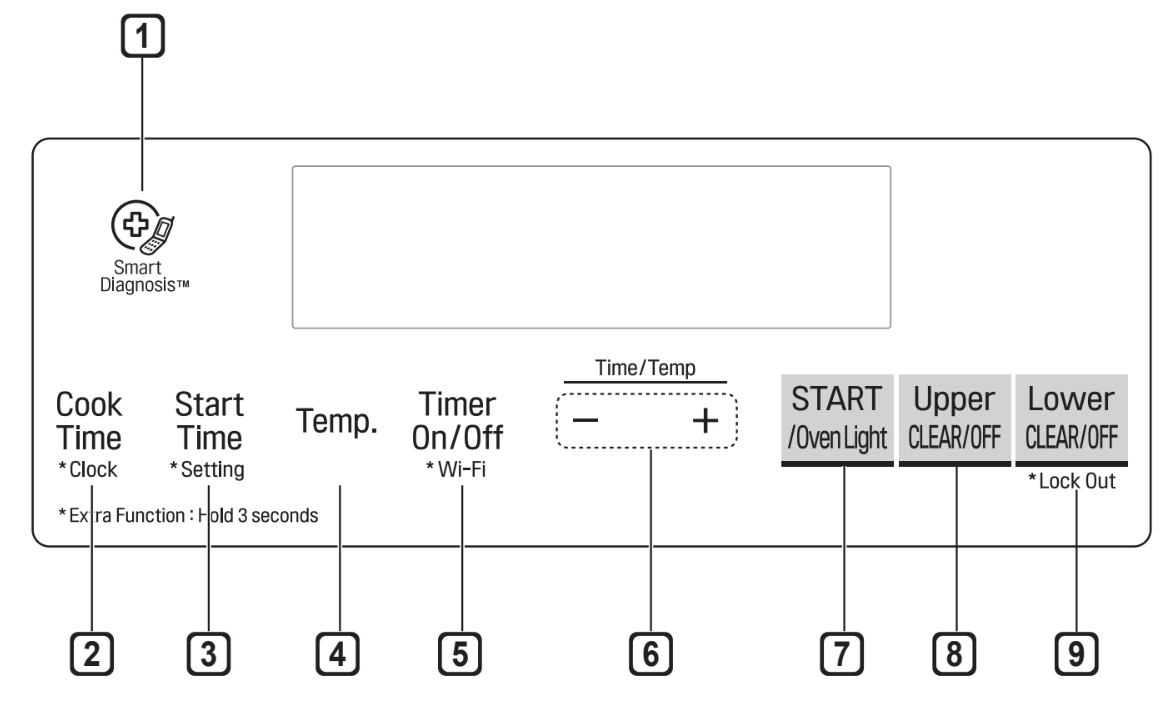
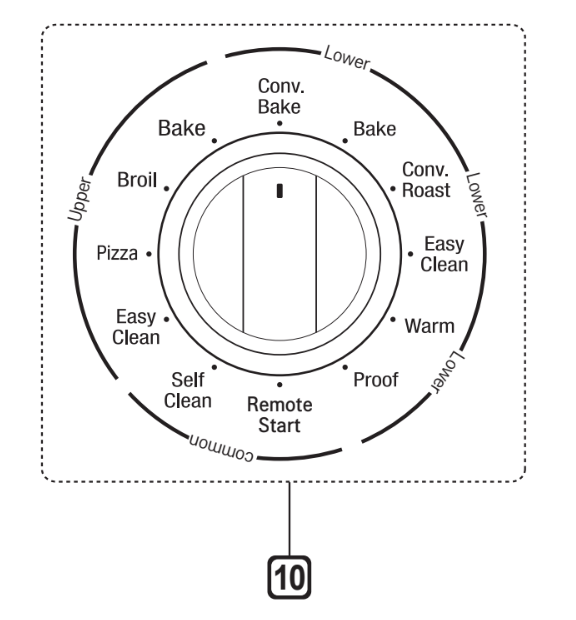
- Smart DiagnosisTM
Use during the Smart Diagnosis feature.
2. Cook Time / Clock
- Press the button to set the desired amount of time for food to cook. The oven shuts off when the set cooking time runs out.
- Press and hold button for three seconds to set the time of day.
3. Start Time / Setting
- Press the button to set the delayed timed cook. The oven starts at the set time.
- Press and hold button for three seconds to select and adjust oven settings.
4. Temp.
Press the button to change the oven or meat probe temperature during cooking.
5. Timer On/Off / Wi-Fi
- Press the button to set or cancel automatic timer.
- Press and hold button for three seconds to connect to Wi-Fi network.
Press the plus button to increase cooking time or oven temperature.
6. -/+
Press the minus button to decrease cooking time or oven temperature.
7. START / Oven Light
- Press the button to start all oven features.
- Press the button to manually turn the oven light on/ off.
8. Upper CLEAR/OFF
Press the button to end all upper oven features.
9. Lower CLEAR/OFF / Lock Out
- Press the button to end all lower oven feature.
- Press and hold button for three seconds to lock the door and control panel.
10. Oven Mode Knob
Turn the knob to select oven operating mode.
Changing Oven Settings
Clock
The clock must be set to the correct time of day in order for the automatic oven timing functions to work properly.
- Press and hold Cook Time for three seconds. CLO shows in the display.
- Press plus(+) or minus(-) to select the desired time. Plus(+) to increase the time and minus(-) to decrease the time.
- Press Start to enter the time and start the clock.
Oven Light
The interior oven light automatically turns on when the door is opened. Touch Light to manually turn the oven light on.
Minimum & Maximum Default Settings
All of the features listed have a minimum and a maximum time or temperature setting that can be entered into the control. A beep sounds each time a control key is touched.
Two short tones sound if the entry of the temperature or time is below the minimum or above the maximum setting for the feature.
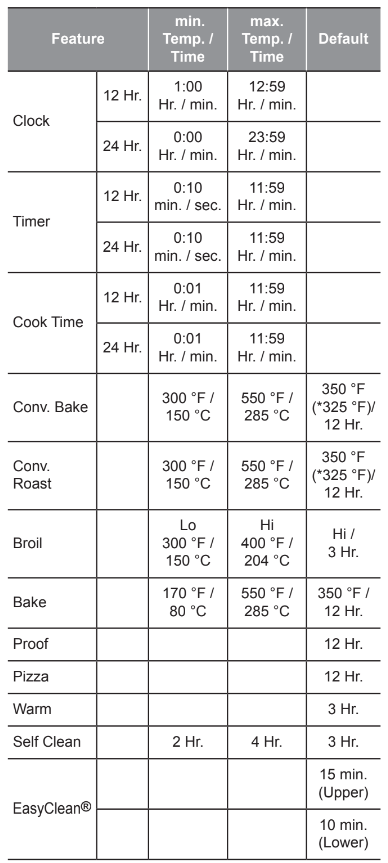
Timer On/Off
The Lower Timer On/Off serves as an extra timer in the kitchen that beeps when the set time has run out.
It does not start or stop cooking.
The Timer On/Off feature can be used during any of the oven control functions.
Setting the Timer
- Press Timer On/Off. 0:00 with HR inside it appears and Timer flashes in the display.
- Press plus(+) or minus(-) to select the desired time. Plus(+) increases the time and minus(-) decreases the time.
- Press Timer On/Off or Start to start the Timer. The remaining time countdown appears in the display.
- When the set time runs out, End shows in the display. The indicator tones sound every seconds until Timer On/Off is pressed.
Cancelling the Timer
- Press Timer On/Off once. The display returns to the time of day.
Wi-Fi
The Wi-Fi button is used to connect the appliance to a home Wi-Fi network.
- Press Upper CLEAR/OFF and Lower CLEAR/ OFF.
- Press and hold Timer On/Off for 3 seconds.
- The power-on chime sounds, Set appears in the display, and the Wi-Fi icon (
 ) blinks.
) blinks. - Register the appliance on the Wi-Fi network using the smart phone app. (See page 40.)
- To disconnect the appliance from the network, delete it from the registered appliances in the app.
Settings
Press and hold Start Time for three seconds.
Then press the Start Time key repeatedly to toggle through and change oven settings.
The Setting key allows you to:
- set the hour mode on the clock (12 or 24 hours)
- enable/disable convection auto conversion
- adjust the oven temperature
- activate/deactivate the preheating alarm light
- set the beeper volume
- switch the temperature scale between Fahrenheit and Celsius
Setting the Hour Mode
The control is set to use a 12-hour clock. To reset the clock to 24-hour mode, follow the steps below.
- Press and hold Start Time for three seconds.
- Press plus(+) or minus(-) to set the desired hour mode on the clock.
- Press Start to accept the desired change.
Setting Convection Auto Conversion
When Conv. Bake and Conv. Roast are selected, Convection Auto Conversion automatically converts the standard recipe temperature entered to a convection temperature by subtracting 25 °F / 14 °C. This auto-converted temperature shows on the display. For example, select Conv. Bake, enter 350 °F, and 325 °F shows on the display after preheat.
Convection Auto Conversion is enabled by default. To change the setting, follow these instructions.
- Press and hold Start Time for three seconds. Then press Start Time repeatedly until Auto appears in the display
- Press plus(+) or minus(-) to enable or disable the feature.
- Press Start to accept the change.
Adjusting the Oven Temperature
Your new oven may cook differently from the one it replaced. Use your new oven for a few weeks to become more familiar with it before changing the temperature settings. If after familiarizing yourself with the new oven, you still think that it is too hot or too cold, you can adjust the oven thermostat yourself.
- Press and hold Start Time for three seconds. Then press Start Time repeatedly until U_AJ or L_AJ appears in the display.
- To increase the temperature, press plus (+) until the desired amount appears in the display. To decrease the temperature, press minus (-) until the desired amount appears in the display.
- Press Start to accept the change.
Turning the Preheat Alarm Light On/Off
When the oven reaches its set-temperature, the preheating alarm light flashes 5 times or until the oven door is opened.
You can activate or deactivate the preheating alarm light.
- Press and hold Start Time for three seconds. Then press Start Time repeatedly until PrE appears in the display.
- Press plus(+) or minus(-) to turn the function on/off.
- Press Start to accept the change.
Adjusting the Beeper Volume
- Press and hold Start Time for three seconds. Then press Start Time repeatedly until BEEP appears in the display.
- Press plus(+) or minus(-) to select Hi, Lo or Off.
- Press Start to accept the change.
Selecting Fahrenheit or Celsius
Set the oven temperature display to show either Fahrenheit (°F) or Celsius (°C) units. The oven defaults to Fahrenheit unless changed by the user.
- Press and hold Start Time for three seconds. Then press Start Time repeatedly until Unit appears in the display.
- Press plus(+) or minus(-) to select F(Fahrenheit) or C(Celsius).
- Press Start to accept the change.
Lock Out
The Lock Out feature automatically locks the oven door and prevents most oven controls from being turned on. It does not disable the clock, timer or the interior oven light.
- Press and hold Lower CLEAR/OFF for three seconds.
- The lock melody sounds, Loc appears in the display, and the lock icon blinks in the display.
- Once the oven door is locked, the lock indicator stops blinking and remains on.
- To deactivate the Lock Out feature, press and hold Lower CLEAR/OFF for three seconds. The unlock melody sounds and the door and the controls unlock.
Start Time (Delayed Timed Cook)
The automatic timer of the Delayed Timed Cook function turns the oven on and off at the time you select. This feature can be used with the Bake, Conv. Bake and Conv. Roast modes.
Setting a Delayed Timed Cook
For example, to bake at 300 °F and delay the start of baking until 4:30, first set the clock for the correct time of day.
- Turn the oven mode knob to select the Bake mode. 350 °F appears in the display.
- Set the temperature: press minus(-) until 300 °F appears in the display.
- Press Cook Time and press plus(+) or minus(-) to set the baking time.
- Press Start Time.
- Set the start time: press plus(+) until 4:30 appears in the display.
- Press Start. A short beep sounds and Timed Delay and the start time appear in the display. The oven begins baking at the set start time.
The oven will continue to cook for the set amount of time and then turn off automatically. When the cooking time has elapsed:
End and the time of day show in the display.
The cook-end indicator tone sounds every 60 seconds until CLEAR/OFF is pressed.
Cook Time (Timed Cook)
Set the oven to cook for a specific length of time using the Timed Cook feature. This feature can only be used with the Bake, Conv. Bake and Conv. Roast modes.
Setting the Cook Time Function
For example, to bake at 300 °F for 30 minutes, first set the clock to the correct time of day.
- Turn the oven mode knob to select the Bake mode. 350 °F appears in the display.
- Set the oven temperature. For this example, press minus(-) until 300 °F appears in the display.
- Press Cook Time. Timed flashes in the display. Bake, 0:00 and 300 °F appear in the display.
- Set the baking time: press plus(+) until 30:00 appears in the display. The baking time can be set for any amount of time between 1 minute and 11 hours and 59 minutes.
- Press Start.
The oven will continue to cook for the set amount of time and then turn off automatically. When the cooking time has elapsed:
End and the time of day show in the display.
The cook end indicator tone sounds every 60 seconds until CLEAR/OFF is pressed.
Changing the Cook Time during Cooking
For example, to change the cook time from 30 minutes to 1 hour and 30 minutes, do the following.
- Press Cook Time.
- Change the baking time: press plus(+) until hour and 30 minutes appears in the display.
- Press Start to accept the change.
Removing and Replacing the Oven Racks
Removing Racks
- While wearing oven mitts, grasp the oven rack*.
- Pull the rack straight out until it stops.
- Lift up the front of the rack.
- Pull out the rack.
When possible, adjust oven racks before using the oven. Always wear oven mitts if adjusting racks while the oven is on.
Replacing Racks
- While wearing oven mitts, place the end of the rack on the support*
- Tilt the front end of the rack up.
- Push the rack in.
- Check that the rack is properly in place.
When possible, adjust oven racks before using the oven. Always wear oven mitts if adjusting racks while the oven is on.
Recommended Baking and Roasting Guide
- Center pans on racks for best baking results. If baking with more than one pan, place the pans so that each one has at least 1" to 11/2" of air space around it. Do not allow pans to touch the walls of the oven.
- If cooking on a single rack, place the heavy rack in position 1 in the upper oven and position 1 in the lower oven. Center the cookware as shown in the single rack image.
- If cooking on multiple racks in the lower oven, place a heavy rack in position 1 and position 4. Center the cookware as shown in the multiple rack image.
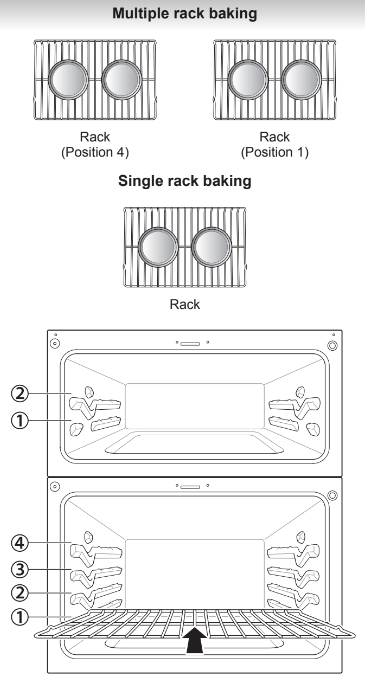
Bake
Bake is used to prepare foods such as pastries, breads and casseroles. The oven can be programmed to bake at any temperature from 170 °F (80 °C) to550°F (285 °C). The default temperature is 350 °F (175°C).
Setting the Bake Function (example, 375 °F)
- Turn the oven mode knob to select Bake.
- Set the oven temperature: for example, press plus(+) until 375 °F appears in the display.
- Press Start. The oven starts to preheat.
As the oven preheats, the temperature is displayed and rises in 5-degree increments. Once the oven reaches the set temperature, a tone sounds and the oven light blinks on and off.
4. When cooking is complete, press CLEAR/OFF.
5. Remove food from the oven.
Baking Chart
This chart is only for reference and can be used for both the upper and lower ovens. Adjust the cook time according to your recipe.
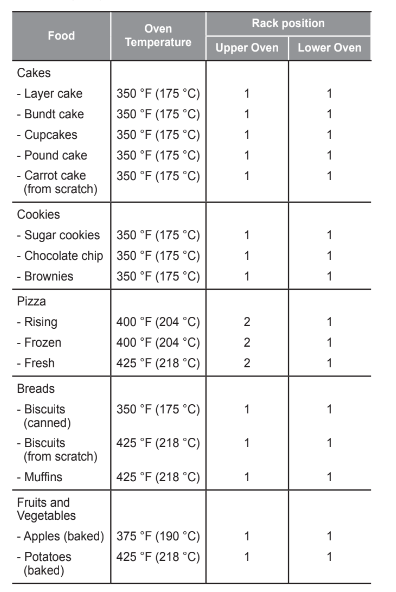
Convection Mode
The convection system uses a fan to circulate heat evenly within the oven. This improves heat distribution and allows for even cooking and excellent results, especially when using multiple racks. Convection cooking can also shorten cooking times.
Convection Bake
Setting the Conv. Bake Function (example: to Conv. Bake at 350°F)
- Turn the oven mode knob to select Conv. Bake.
- Set the oven temperature: press plus(+) until 375°F appears in the display.
- Press Start. The display shows Conv. Bake and the converted temperature starting at 100 °F. As the oven preheats, the displayed temperature will increase in 5-degree increments.
- Once the oven reaches the desired temperature, a tone sounds and the oven light blinks on and off. The display shows the auto converted oven temperature: 350 °F, Conv. Bake and .
- Place food in oven.
- Convection Bake cooks faster and more evenly when cooking foods like cookies, biscuits, rolls, or other baked goods on a single rack. Cookies, muffins, and biscuits will have very good results when using multiple racks.
- Multiple rack cooking may slightly increase times for some foods, but the overall time is reduced.
- Convection Bake gives excellent results for quick breads and yeast breads of all kinds, and breads and pastries brown more evenly.
- Do not use Convection Bake for delicate items like custards, souffles, or cheesecakes, which may be disturbed by the convection fan.
Convection Baking Chart
If auto conversion is disabled, reduce standard recipe temperature by 25 °F (14 °C) for Convection Bake. Temperatures have been adjusted in this chart. Multi-rack cooking may slightly increase cook times for some foods, but the overall time is reduced.
This chart is only for reference. Adjust cooking time according to your preference.
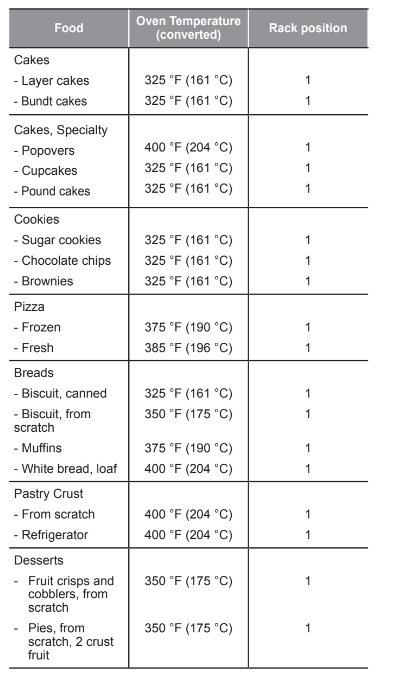
Cookware for Convection Cooking
Any cookware safe for use in a conventional oven will work in a convection oven. But for best results, keep the following in mind.
- Make sure pans don’t touch the oven walls when centered on the racks. Use cookware that leaves room for air circulation in the oven for best results when convection cooking.
- Leave space between pans. Make sure pans don't touch each other or the oven walls.
- Do not use pans with high sides. Use flat pans with no sides for cookies or biscuits. Use a pan with low sides for oven-baked chicken.
- Metal pans heat the fastest. Heat-resistant paper and plastic containers that are recommended for use in regular ovens can be used in convection ovens. Glass and ceramic pans can also be used.
- However, metal pans heat the fastest and are recommended for convection cooking.
- Food cooked on pans with dark or matte finishes cooks faster than food on pans with shiny finishes.
- Use the pan size recommended in the recipe.
Convection Roast
The Convection Roast feature is designed to give optimum roasting performance. Convection Roast combines cooking with the convection fan to roast meats and poultry. The heated air circulates around the food from all sides, sealing in juices and flavors.
Food cooked in this manner is crispy brown on the outside while staying moist on the inside.
Setting the Conv. Roast Function (example: to Conv. Roast at 350°F)
- Turn the oven mode knob to select Conv. Roast.
- Set the oven temperature: press plus(+) until 375°F appears in the display.
- Press Start. The display shows Conv. Roast and the changing temperature starting at 100 °F. As the oven preheats, the displayed temperature will increase in 5-degree increments.
- Once the oven reaches the desired temperature, a tone sounds and the oven light flashes on and off. The display shows the auto converted oven temperature: 350 °F, Conv. Roast and .
- Place food in oven.
SMART FUNCTIONS
LG SmartThinQ Application
The LG SmartThinQ application allows you to communicate with the appliance using a smartphone.
Before Using LG SmartThinQ
For appliances with the  logo
logo
1.Use a smartphone to check the strength of the wireless router (Wi-Fi network) near the appliance.
- If the distance between the appliance and the wireless router is too far, the signal strength becomes weak. It may take a long time to register or installation may fail.
2. Turn off the Mobile data or Cellular Data on your smartphone.
- For iPhones, turn data off by going to Settings Cellular → Cellular Data.

3.Connect your smartphone to the wireless router.

Installing the LG SmartThinQ Application
Search for the LG SmartThinQ application from the Google Play Store or Apple App Store on a smart phone. Follow instructions to download and install the application.
LG SmartThinQ Application Features
- For appliances with the
 logo
logo
Cleaning
This function helps you to check the energy efficiency, usage and guide of EasyClean®.
Smart DiagnosisTM
This function provides useful information for diagnosing and solving issues with the appliance based on the pattern of use.
Settings
Allows you to set various options on the oven and in the Application.
Monitoring
This function helps you recognize the current status, remaining time, cook settings and end time on the screen.
Push Alerts
Turn on the Push Alerts to receive appliance status notifications.
The notifications are triggered even if the LG SmartThinQ application is off.
Timer
You can set the timer from the application.
Firmware Update
Keep the appliance updated.
Smart DiagnosisTM Function
Should you experience any problems with the appliance, it has the capability of transmitting data via your telephone to the LG Customer Information Center. NFC or Wi-Fi equipped models can also transmit data to a smartphone using the LG SmartThinQ application.
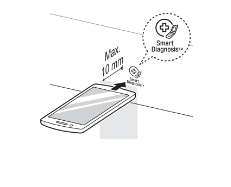
Smart DiagnosisTM through the Customer Information Center
- For appliances with the or logo
This method allows you to speak directly to our trained specialists. The specialist records the data transmitted from the appliance and uses it to analyze the issue, providing a fast and effective diagnosis.
- Call the LG call center at: (LG U.S.) 1-800-243- LG Canada) 1-888-542-2623.
- When instructed to do so by the call center agent, hold the mouthpiece of your phone over the Smart DiagnosisTM logo on the machine. Hold the phone no more than one inch from (but not touching) the machine.
- Press and hold the Start button for three seconds.
- Keep the phone in place until the tone transmission has finished. This takes about 6 seconds and the display will count down the time.
- Once the countdown is over and the tones have stopped, resume your conversation with the call center agent, who will then be able to assist you in using the information transmitted for analysis.
LG SmartThinQ Smart DiagnosisTM
- For appliances with the
 logo
logo
Use the Smart Diagnosis feature in the LG SmartThinQ application for help diagnosing issues with the appliance without the assistance of the LG Customer Information Center.
Follow the instructions in the LG SmartThinQ application to perform a Smart Diagnosis using your smartphone.
- Open the LG SmartThinQ application on the smart phone.
- In the application, select the appliance from your list of connected appliances and then press the dots at the upper right of the screen.
- Select Smart Diagnosis, then press the Start Smart Diagnosis button.
- Select the Audible Diagnosis.
- Follow the instructions on the smart phone.
- Keep the phone in place until the tone transmission has finished. View the diagnosis on the phone.
Open Source Software Notice Information
To obtain the source code under GPL, LGPL, MPL, and other open source licenses, that is contained in this product, please visit http://opensource.lge.com.
In addition to the source code, all referred license terms, warranty disclaimers and copyright notices are available for download.
LG Electronics will also provide open source code to you on CD-ROM for a charge covering the cost of performing such distribution (such as the cost of media, shipping, and handling) upon email request to [email protected]. This offer is valid for a period of three years after our last shipment of this product. This offer is valid to anyone in receipt of this information.
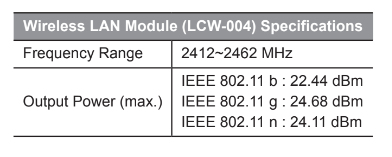
FCC Notice (For transmitter module contained in this product)
This equipment has been tested and found to comply with the limits for a Class B digital device, pursuant to Part 15 of the FCC Rules. These limits are designed to provide reasonable protection against harmful interference in a residential installation. This equipment generates, uses, and can radiate radio frequency energy and, if not installed and used in accordance with the instructions, may cause harmful interference to radio communications. However, there is no guarantee that interference will not occur in a particular installation. If this equipment does cause harmful interference to radio or television reception, which can be determined by turning the equipment off and on, the user is encouraged to try to correct the interference by one or more of the following measures:
- Reorient or relocate the receiving antenna.
- Increase the separation between the equipment and the receiver.
- Connect the equipment to an outlet on a circuit different from that to which the receiver is connected.
- Consult the dealer or an experienced radio/TV technician for help.
This device complies with part 15 of the FCC Rules.
Operation is subject to the following two conditions:
- this device may not cause harmful interference and
- this device must accept any interference received, including interference that may cause undesired operation of the device.
Any changes or modifications in construction of this device which are not expressly approved by the party responsible for compliance could void the user’s authority to operate the equipment.
FCC RF Radiation Exposure Statement
This equipment complies with FCC radiation exposure limits set forth for an uncontrolled environment. This transmitter must not be co-located or operating in conjunction with any other antenna or transmitter.
This equipment should be installed and operated with a minimum distance of 20 cm (7.8 inches) between the antenna and your body. Users must follow the specific operating instructions for satisfying RF exposure compliance.
MAINTENANCE
Removing and Replacing the Gas Surface Burners
Grates and burner head / cap can be removed for care and cleaning.

Cleaning Burner Heads/Caps
For even and unhampered flame, the slits in the burner heads must be kept clean at all times.The burner heads and caps (and the oval burner head and cap assembly) can be lifted off. Do not attempt to remove the oval burner cap.
- Wash the burner caps in hot soapy water and rinse with clean water. Run water through the oval burner from the bottom stem to flush out debris.
- Use care when cleaning the cooktop. The pointed metal ends on the electrodes could cause injury.
- Hitting an electrode with a hard object may damage it.
- To remove burnt-on food, soak the burner heads in a solution of mild liquid detergent and hot water for 20–30 minutes. For stubborn stains, use a toothbrush or wire brush.
- The burners will not operate properly if the burner ports or electrodes are clogged or dirty.
- Burner caps and heads should be cleaned routinely, especially after excessive spillover.
- Burners will not light if the cap is removed.
After Cleaning the Burner Heads/ Caps
Shake out any excess water and then let the parts dry thoroughly. Placing the oval burner upside down will allow the water to drain out more easily. Replace the burner heads and caps over the electrodes on the cooktop in the correct locations according to their size. Make sure the hole in the burner head is positioned over the electrode.
Burner Grates
The range consists of three separate professional- style grates. For maximum stability, these grates should only be used when in their proper position.
The two side grates can be interchanged from left to right and front to back. The center grate can be interchanged from front to back.
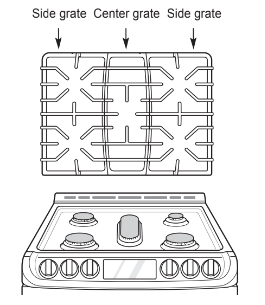
Cleaning the Burner Grates
Grates should be washed regularly and after spillovers.
Wash the grates in hot, soapy water and rinse with clean water.
The grates are dishwasher safe.
After cleaning the grates, let them dry completely and securely position them over the burners.
Cleaning the Cooktop Surface
Foods with high acid or sugar content may cause a dull spot if allowed to set. Wash and rinse soon after the surface has cooled. For other spills such as oil/ grease spattering, etc., wash with soap and water when the surface has cooled, then rinse and polish with a dry cloth.
Oven Air Vents
Air openings are located at the rear of the cooktop, at the top and bottom of the oven door, and at the bottom of the range.
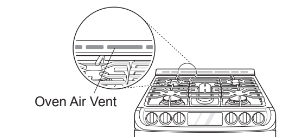
Control Panel
To prevent activating the control panel during cleaning, unplug the range. Clean up splatters with a damp cloth using a glass cleaner. Remove heavier soil with warm, soapy water. Do not use abrasives of any kind.
Front Manifold Panel and Knobs
It is best to clean the manifold panel after each use of the range. For cleaning, use a damp cloth and mild soapy water or a 50/50 solution of vinegar and water.
For rinsing, use clean water and polish dry with a soft cloth.
Cleaning the Exterior
Painted and Decorative Trim
For general cleaning, use a cloth with hot soapy water. For more difficult soils and built-up grease, apply a liquid detergent directly onto the soil. Leave it on for 30 to 60 minutes. Rinse with a damp cloth and dry. Do not use abrasive cleaners.
Stainless Steel Surfaces
To avoid scratches, do not use steel wool pads.
- Place a small amount of stainless steel appliance cleaner or polish on a damp cloth or paper towel.
- Clean a small area, rubbing with the grain of the stainless steel if applicable.
- Dry and buff with a clean, dry paper towel or soft cloth.
- Repeat as necessary.
Oven Door
Use soapy water to thoroughly clean the oven door.
Rinse well. Do not immerse the door in water.
You may use a glass cleaner on the outside glass of the oven door. Do not spray water or glass cleaner on the door vents.
Do not use oven cleaners, cleaning powders, or harsh abrasive cleaning materials on the outside of the oven door.
Do not clean the oven door gasket. The oven door gasket is made of a woven material that is essential for a good seal. Care should be taken not to rub, damage, or remove this gasket.
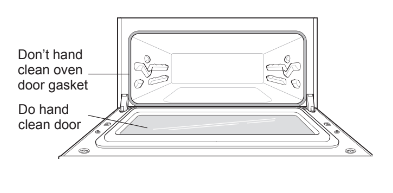
Door Care Instructions
Most oven doors contain glass that can break.
Oven Racks
Remove the oven racks before operating the self clean cycle and EasyClean®.
- Food spilled into the tracks could cause the racks to become stuck. Clean racks with a mild, abrasive cleaner.
- Rinse with clean water and dry.
EasyClean®
LG’s EasyClean® enamel technology provides two cleaning options for the inside of the range. The EasyClean® feature takes advantage of LG’s new enamel to help lift soils without harsh chemicals, and it runs using ONLY WATER for just 10 minutes(Lower) minutes(Upper) in low temperatures to help loosen LIGHT soils before hand-cleaning.
While EasyClean® is quick and effective for small and LIGHT soils, the Self Clean feature can be used to remove HEAVY, built up soils. The intensity and high heat of the Self Clean cycle may result in smoke which will require the opening up of windows to provide ventilation. Compared to the more intense Self Clean process, your LG oven gives you the option of cleaning with LESS HEAT, LESS TIME, and virtually NO SMOKE OR FUMES.
When needed, the range still provides the self clean option for longer, more thorough oven cleaning for heavier, built up soils.
Benefits of EasyClean®
- Helps loosen light soils before hand-cleaning
- EasyClean® only uses water; no chemical cleaners
- Makes for a better self-clean experience
- Delays the need for a self-clean cycle
- Minimizes smoke and odor
- Can allow for shorter self-clean time
When to Use EasyClean®

Cleaning Tips
Allow the oven to cool to room temperature before using the EasyClean® cycle. If your oven cavity is above 150 °F (65 °C), Hot will appear in the display, and the EasyClean® cycle will not be activated until the oven cavity cools down.
- A plastic spatula can be used as a scraper to scrape off any chunks or debris before and during oven cleaning.
- Using the rough side of a non-scratch scouring pad may help to take off burnt-on stains better than a soft sponge or towel.
- Certain non-scratch scrubbing sponges, such as those made of melamine foam, available at your local stores, can also help improve cleaning.
- The range should be level to ensure that the bottom surface of the oven cavity is entirely covered by water at the beginning of the EasyClean® cycle.
- For best results, use distilled or filtered water. Tap water may leave mineral deposits on the oven bottom.
- Soil baked on through several cooking cycles will be more difficult to remove with the EasyClean® cycle.
- Do not open the oven door during the EasyClean® cycle. Water will not get hot enough if the door is opened during the cycle.
- For hard to reach areas such as the back surface of the lower oven, it is better to use the Self Clean cycle.
EasyClean® Instruction Guide
1. Remove oven racks and accessories from the oven.
2. Scrape off and remove any burnt-on debris with a plastic scraper
Suggested plastic scrapers:
- Hard plastic spatula
- Plastic pan scraper
- Plastic paint scraper
- Old credit card

3. Fill a spray bottle (10 oz or 300 ml) with water and use the spray bottle to thoroughly spray the inside surfaces of the oven.
4. Use at least 1/5 (2 oz or 60 ml) of the water in the bottle to completely saturate the soil on both the walls and in the corners of the oven.
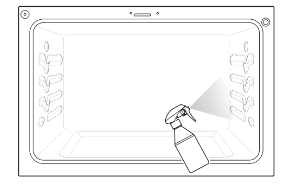
5. Spray or pour the remaining water (8 oz or 240 ml) onto the bottom center of the oven cavity.
The indentation on the oven bottom should be fully covered to submerge all soils. Add water if necessary.
6. Close the oven door.
Turn the oven mode knob to select EasyClean®. Press Start.
7. A tone will sound at the end of the 10 minute (Lower) / 15 minute (Upper) cycle. Touch CLEAR/OFF to clear the display and end the tone.
8. After the cleaning cycle and during hand- cleaning, enough water should remain on the oven bottom to completely submerge all soils.
Add water if necessary. Place a towel on the floor in front of the oven to capture any water that may spill out during hand-cleaning. If you are cleaning the upper oven on a double oven range, it is also best to cover the holes in the top of the lower oven door with a towel to capture any water that may drip into the door during hand cleaning.
9. Clean the oven cavity immediately after the EasyClean® cycle by scrubbing with a wet, non-scratch scouring sponge or pad. (The scouring side will not scratch the finish.) Some water may spill into the bottom vents while cleaning, but it will be captured in a pan under the oven cavity and will not hurt the burner.
10. Once the oven cavity is cleaned, wipe any excess water with a clean dry towel. Replace racks and any other accessories.
11. If some light soils remain, repeat the above steps, making sure to thoroughly soak the soiled areas. If stubborn soils remain after multiple EasyClean® cycles, run the Self Clean cycle. Be sure that the oven cavity is empty of oven racks and other accessories, and that the oven cavity surface is dry before running the Self Clean cycle. Consult the Self Clean section of your owner’s manual for further details.
If a self-clean option is not available, scrape off and remove stubborn soil using a scraper.
Self Clean
The Self Clean cycle uses extremely hot temperatures to clean the oven cavity. While running the Self Clean cycle, you may notice smoking or an odor. This is normal; especially if the oven is heavily soiled.
During Self Clean, the kitchen should be well ventilated to minimize the odors from cleaning.
Before Starting Self Clean
- Remove the oven racks, broiler pan, broiler grid, all cookware, aluminum foil or any other material from the oven.
- The kitchen should be well ventilated to minimize the odors from cleaning.
- Wipe any heavy spillovers on the bottom of the oven.
- Make sure that the oven light bulb cover is in place and the oven light is off.
- The oven light cannot be turned on during a Self Clean cycle. The oven light cannot be turned on until the oven temperature has cooled below 500°F (260 ̊C) after a Self Clean cycle is complete.
Setting Self Clean
The Self Clean function has cycle times of 2, 3, or 4 hours.
Self Clean Soil Guide

- Remove all racks and accessories from the oven.
- Turn the oven mode knob to select Self Clean. The oven defaults to the recommended three- hour self clean for a moderately soiled oven. Press plus(+) or minus(-) repeatedly to cycle through self-clean times in the upper or lower oven. Both ovens cannot use the self-clean function at the same time.
- Press Start.
- Once the self-clean cycle is set, the oven door locks automatically and the lock icon displays. You will not be able to open the oven door until the oven has cooled. The lock releases automatically when the oven has cooled.
Setting Self Clean with a Delayed Start
- Remove all racks and accessories from the oven.
- Turn the oven mode knob to select Self Clean. The oven defaults to the recommended three- hour self clean for a moderately soiled oven. Press plus(+) or minus(-) repeatedly to cycle through self-clean times in the upper or lower oven. Both ovens cannot use the self-clean function at the same time.
- Press Start.
- Press plus(+) or minus(-) to enter the time of day you would like the Self Clean to start.
- Press Start.
During Self Clean
- The Self Clean cycle uses extremely hot temperatures to clean the oven cavity. While running the Self Clean cycle, you may notice smoking or an odor. This is normal, especially if the oven is heavily soiled.
- As the oven heats, you may hear sounds of metal parts expanding and contracting. This is normal and will not damage the oven.
- Do not force the oven door open when the lock is displayed. The oven door remains locked until the oven temperature has cooled. Forcing the door open will damage the door.
After the Self Clean Cycle
- The oven door remains locked until the oven temperature has cooled.
- You may notice some white ash in the oven. Wipe it off with a damp cloth or a soap-filled steel wool pad after the oven cools. If the oven is not clean after one self-clean cycle, repeat the cycle.
- If oven racks were left in the oven and do not slide smoothly after a self-clean cycle, wipe racks and rack supports with a small amount of vegetable oil to make them glide more easily.
- Fine lines may appear in the porcelain because it went through heating and cooling. This is normal and will not affect performance.
Changing the Oven Light
The oven light is a standard 40-watt appliance bulb. It turns on when the oven door is open. When the oven door is closed, touch Start to turn it on or off.
- Unplug the range or disconnect power.
- Turn the glass bulb cover in the back of the oven counterclockwise to remove.
- Turn the bulb counterclockwise to remove it from the socket.
- Insert the new bulb and turn it clockwise.
- Insert the glass bulb cover and turn it clockwise.
- Plug in the range or reconnect the power.
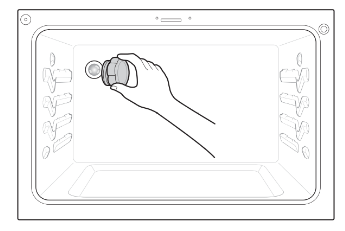
Removing and Replacing the Lift-Off Oven Doors
Upper Oven
Removing the Door
1. Fully open the door.
2. Lift up and rotate the hinge locks toward the hinge until they stop.

3. Close the door to 30 degrees (you will feel the door stop). The hinge locks will contact the oven frame.
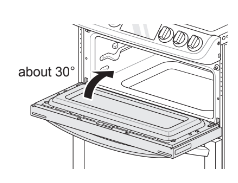
4. On both sides of the door, press down on the release button on each hinge.
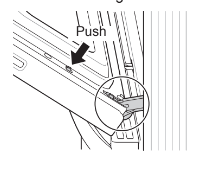
5. Lift the door up until it is clear of the hinges.
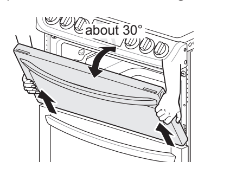
Replacing the Door
1. Be sure both hinges are in a 30 degree position.
2. Slide the door back onto the hinges until you hear a solid click and the release buttons have engaged.
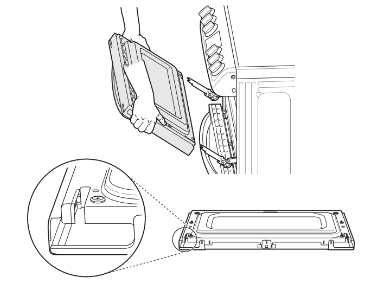
3. Fully open the door.
4. Push the hinge locks down onto the door frame.

5. Close the oven door.
Lower Oven
Removing the Door
1. Fully open the door.
2. Unlock the hinge locks, rotating them as far toward the open door frame as they will go.
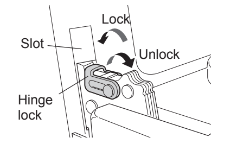
3. Firmly grasp both sides of the door at the top.
4. Close the door to the removal position approximately five degrees) which is halfway between the broil stop position and fully closed. If the position is correct, the hinge arms will move freely.
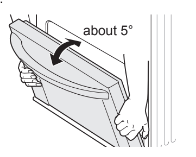
5. Lift door up and out until the hinge arms are clear of the slots.
Replacing the Door
1. Firmly grasp both sides of the door at the top.
2. With the door at the same angle as the removal position, seat the indentation of the hinge arms into the bottom edge of the hinge slots. The notch in the hinge arms must be fully seated into the bottom edge of the slots.
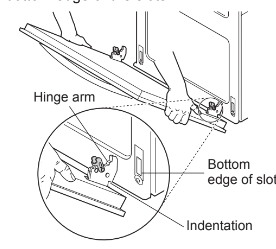
3. Open the door fully. If the door will not open fully, the indentation is not seated correctly in the bottom edge of the slots.
4. Lock the hinge locks, rotating them back toward the slots in the oven frame until they lock.
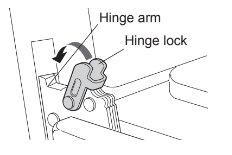
5. Close the oven door.
TROUBLESHOOTING
FAQs
What types of cookware are recommended for use with the cooktop?
- The pans must have a flat bottom and straight sides.
- Only use heavy-gauge pans.
- The pan size must match the amount of food to be prepared and the size of the surface element.
- Use tight fitting lids.
- Only use flat-bottom woks.
Why do the heating elements appear to be turning ON and OFF during use of the cooktop or oven?
Depending on your cooktop element setting or the temperature selected in your oven it is NORMAL for the cooking elements to cycle on and off.
My new oven doesn’t cook like my old one. Is there something wrong with the temperature settings?
No, your oven has been factory tested and calibrated.
For the first few uses, follow your recipe times and temperatures carefully. If you still think your new oven is too hot or too cold, you can adjust the oven temperature yourself to meet your specific cooking needs. Refer to the Oven Temperature Adjustment section in this manual for easy instructions on how to adjust your thermostat.
Is it normal to hear a clicking noise coming from the back of my oven when I am using it?
Your new range is designed to maintain a tighter control over your oven’s temperature. You may hear your oven’s heating elements click on and off more frequently on your new oven. This is NORMAL.
Why is the time flashing?
This means that the product has just been plugged in, or that it has experienced a power interruption. To clear the flashing time, touch any button and reset the clock if needed.
During convection cooking the fan stops when I open the door. Is that normal?
Yes, this is normal. When the door is opened, the convection fan will stop until the door is closed.
Can I use aluminum foil to catch drippings in my oven cavity?
Never use aluminum foil to line the bottom or sides of the oven or the warming drawer. The foil will melt and stick to the bottom surface of the oven, and will not be removable. Use a sheet pan placed on a lower oven rack to catch drippings instead. (If foil has already melted onto the bottom of the oven, it will not interfere with the oven’s performance.)
Can I use aluminum foil on the racks?
Do not cover racks with aluminum foil. Covering entire racks with foil restricts air flow, leading to poor cooking results. Use a sheet pan lined with foil under fruit pies or other acidic or sugary foods to prevent spillovers from damaging the oven finish.
Can I leave my racks in the oven when running a Self Clean cycle?
No. Although it will not damage the racks, it will discolor them and may make them hard to slide in and out during use. Remove all items from the oven before starting a Self Clean cycle.
What should I do if my racks are sticky and have become hard to slide in and out?
Over time, the racks may become hard to slide in and out. Apply a small amount of olive oil to the ends of the racks. This will work as a lubricant for easier gliding.
What should I do for hard to remove stains on my cooktop?
The cooktop should be cleaned after every use to prevent permanent staining. When cooking foods with high sugar content, such as tomato sauce, clean the stain off with a scraper while the cooktop is still warm.
Use an oven mitt when scraping to prevent burns.
Refer to the MAINTENANCE section of this owner's manual for further instruction.
Why aren't the function buttons working?
Make sure that the range is not in Lockout mode.
The lock will show in the display if Lockout is activated. To deactivate Lockout, touch and hold Lower CLEAR/OFF for three seconds. The unlock melody sounds and Loc appears in the display until the controls are unlocked.
My range is still dirty after running the EasyClean® cycle. What else should I do?
The EasyClean® cycle only helps to loosen light soils in your oven range to assist in hand-cleaning of your oven. It does not automatically remove all soils after the cycle. Some scrubbing of your oven range is required after running the EasyClean® cycle.
I tried scrubbing my oven after running EasyClean®, but some soils still remain. What can I do?
The EasyClean® feature works best when the soils are fully soaked and submerged in water before running the cycle and during hand-cleaning. If soils are not sufficiently soaked in water, it can negatively affect the cleaning performance. Repeat the EasyClean® process using sufficient water.
Sugar-based and certain greasy soils are especially hard to clean. If some stubborn soils remain, use the Self Clean feature to thoroughly clean your oven.
Soils on my oven walls are not coming off. How can I get my walls clean?
Soils on the side and rear walls of your oven range may be more difficult to fully soak with water. Try repeating the EasyClean® process with more than the 1⁄4 cup (2 oz or 60 ml) of spray recommended.
Will EasyClean® get all of the soils and stains out completely?
It depends on the soil type. Sugar-based and certain grease stains are especially hard to clean. Also, if stains are not sufficiently soaked in water, this can negatively affect cleaning performance. If stubborn or built-up stains remain, use the Self Clean feature.
Refer to the Self Clean section of your owner's manual.
Are there any tricks to getting some of the stubborn soils out?
Scraping the soils with a plastic scraper before and during hand-cleaning is recommended. Fully saturating soils with water is also recommended.
However, certain types of soils are harder to clean than others. For these stubborn soils, the Self Clean cycle is recommended. Consult the Self Clean section of your owner's manual for details.
Is it safe for my convection fan, broil burner or heater element to get wet during EasyClean®?
Yes. The convection fan, broiler burner or heater element may get a little wet during cleaning. However, direct spray onto the broil burner and heater elements is not necessary because these are self-cleaning during regular use.
Do I need to use all 1 1/4 cups (10 oz or 300 ml) of water for EasyClean®?
Yes. It is highly recommended that 1 cup (8 oz or ml) of water be sprayed or poured on the bottom and an additional 1/4 cup (2 oz or 60 ml) of water be sprayed on walls and other soiled areas to fully saturate the soils for better cleaning performance.
I see smoke coming out of my oven range’s cooktop vents during EasyClean®. Is this normal?
This is normal. This is not smoke. It is actually water vapor (steam) from the water in the oven cavity. As the oven heats briefly during EasyClean®, the water in the cavity evaporates and escapes through the oven vents.
How often should I use EasyClean®?
EasyClean® can be performed as often as you wish.
EasyClean® works best when your oven is LIGHTLY soiled from such things as LIGHT grease splatter and small drops of cheese. Please refer to the EasyClean® section in your owner's manual for more information.
What is required for EasyClean®?
A spray bottle filled with 11⁄4 cups (10 oz or 300 ml) of water, a plastic scraper, a non-scratch scrubbing pad and a towel. You should not use abrasive scrubbers such as heavy-duty scouring pads or steel wool.
Except for a towel, all of the materials you need are included in a special cleaning kit with your new range.
Can I run the EasyClean® cycle on both of my ovens at once?
Yes. You can run the EasyClean® cycle on both ovens at the same time. Some oven surfaces will be hot after the cycle completes running. Avoid leaning or resting on the oven door glass while cleaning the oven cavities.
You cannot run the Self Clean cycle on both ovens at the same time.
Is it safe for water to spill into the oven bottom vents during cleaning?
Some water spillage into the oven bottom vents (gas range) is okay. However, it is recommended to try avoid spilling too much water into the vents.
Before Calling for Service
Before you call for service, review this list. It may save you time and expense. The list includes common occurrences that are not the result of defective workmanship or materials in this appliance.
| Symptoms | Possible Cause / Solution |
| Top burners do not light or do not burn evenly. | • Make sure that the electrical plug is inserted into a live, properly grounded outlet. • Remove the burners and clean them. Check the electrode area for burnt on food or grease. See Cleaning Burner Heads/Caps in the MAINTENANCE section. • Make sure that the burner parts are installed correctly. See Removing and Replacing the Gas Surface Burners in the MAINTENANCE section. |
| Burner flames are very large or yellow. | If the range is connected to LP gas, contact the technician who installed your range or made the conversion. |
| Surface burners light but the oven does not. | Make sure that the oven gas shut-off valve, located behind the range, is fully open. |
| Food does not bake or roast properly. | • Incorrect oven control settings. See Control Panel Overview in the OPERATION section. • Incorrect rack position. See Removing and Replacing the Oven Racks in the OPERATION section. • Incorrect cookware is being used. See Convection Bake in the OPERATION section. • Oven thermostat needs adjustment. • See Adjusting the Oven Thermostat in the OPERATION section. • The Clock is not set correctly. See Changing Oven Settings in the OPERATION section. • Aluminum foil used improperly in the oven. See Removing and Replacing the Oven Racks. |
| Food does not broil properly in the oven. | • Incorrect oven control settings. See Control Panel Overview in the OPERATION section. • The oven door is not closed. See Broil in the OPERATION section. • Aluminum foil used on the broiling pan and grid is not fitted properly. |
| Oven temperature is too hot or too cold. | The oven thermostat needs adjustment. See Adjusting the Oven Thermostat in the OPERATION section. |
| Clock and timer does not work. | • Make sure the electrical plug is inserted into a live, properly grounded outlet. Replace the fuse or reset the circuit breaker. • Improper oven control settings. See Changing Oven Settings in the OPERATION section. |
| Oven light does not work. | The light bulb is loose or defective. Tighten or replace the bulb. • The plug on the range is not completely inserted in the electrical outlet. Make sure the electrical plug is inserted into a live, properly grounded outlet. |
| Self Clean is not working. | The oven temperature is too high to set a self clean operation. Allow the range to cool down to room temperature and reset the controls. • Improper oven control settings. See Self Clean in the MAINTENANCE section. |
| “Crackling” or “popping” sound. | This is the sound of the metal heating up and cooling down during both the cooking and cleaning functions. This is normal. |
| Too much smoke during the Self Clean cycle. | Too much soil in the oven. Open the windows to get rid of the smoke from the room. Touch the Upper Clear/Off or Lower Clear/Off key. Wait until the light goes off before trying to open the oven door. Wipe up the excess soil and reset the clean cycle. |
| The oven door does not open after a Self Clean cycle. | The oven temperature is too high. Wait up to one hour for it to cool down. |
| The oven is not clean after a Self Clean cycle. | Incorrect oven control settings. See Self Clean in the MAINTENANCE section. • The oven was heavily soiled. Clean up heavy spills before beginning the Self Clean cycle. Heavily soiled ovens may need either a longer Self Clean or two Self Clean cycles. |
| Clean and door flash in the display. | The self clean cycle has been selected, but the door is not closed. - Close the oven door. |
| "Loc" message appears when you want to cook. | • Oven is too hot. - Allow the oven to cool below locking temperature. • Allow about one hour for the oven to cool after the completion of a Self Clean cycle. The door can be opened when the lock   is no longer displayed. is no longer displayed.• The control and door may be locked. |
| Oven control beeps and displays an F error code. | Check the main gas shut-off valve or the oven gas shut-off valve and call for service.
|
| The oven racks were cleaned in a Self Clean cycle. | Apply a small amount of vegetable oil to a paper towel and wipe the edges of the oven racks. Do not use lubricant sprays. |
| Clock is flashing. | Power outage or surge. Reset the clock. If the oven was in use, you must reset it by touching the Upper Clear/Off or Lower Clear/Off key. Reset the clock and any cooking function. |
| “Burning” or “oily” odor emitting from the vent. | This is normal in a new oven. To speed the process, set a Self Clean cycle for a minimum of three hours. See Self Clean in the MAINTENANCE section. |
| Strong odor. | An odor from the insulation around the inside of the oven is normal for the first few times the oven is used. |
| Fan noise | • A convection fan may automatically turn on and off. - This is normal. |
| Fan operation | It is normal for the fan to operate periodically throughout a normal bake cycle in the lower oven. This is to ensure even baking results. |
| Burners are not lighting properly after cleaning the cooktop surface. | Make sure that the burner heads and caps are completely dry and properly positioned. |
| When lighting just one burner, clicking noise is heard from all the burners. | This is normal. Electric spark igniters from the burners cause the clicking noise. All the spark igniters on the cooktop will activate when igniting just one burner. |
| Wi-Fi network does not connect properly. | • If the appliance is having trouble connecting to the Wi-Fi network, it may be too far from the router. Purchase a Wi-Fi repeater (range extender) to improve the Wi-Fi signal strength. • The Wi-Fi connection may not connect or may be interrupted because of the home network environment. • The network connection may not work properly depending on the internet service provider. • The surrounding wireless environment can make the wireless network service run slowly. |
| Light can be seen through the oven air vents. | While the Broil function is running, it is normal to see a light between the oven air vents. |
See other models: LSSG3017ST LSE4615BM LDE4415ST LWC3063ST LRG4113ST

